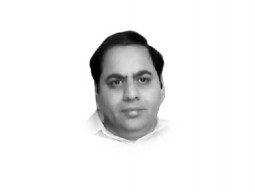
As the nation awaits in suspense to see the conclusion of Azadi and Inqilab marches – organised respectively by Pakistan Tehreek-e-Insaf (PTI) and Pakistan Awami Tehreek (PAT) – there is no visible headway in the resolution of a crisis that has completed its 30 days.
On August 14, Imran Khan’s PTI and Dr Tahirul Qadri’s PAT began their long marches from Lahore and entered Islamabad on August 16 to camp in two parallel roads at Abpara.
Both the parties, while having different goals, had agreement on their demands for the ouster of Sharif brothers and dissolution of parliament.
The protesting parties hoped to have one million people at the marches but they could gather only about 10,000 people each and now just 1,500 to 2,000 are camped in their sit-ins in front of parliament house. Media reports also suggested that some of the protestors were rented people.
The protesting parties first moved to the high security red zone of the capital on August 19 and later on August 30 tried to advance towards the Prime Minister House.

This move was, however, thwarted by the government which used up to 40,000 security and police personnel, who fired tear gas and rubber bullets at the marchers, who dispersed and later took refuge in Parliament House’s lawns.
This led to clashes between protestors and police. The protestors later entered Pakistan Secretariat and damaged some vehicles. They also broke gates and entered the headquarters of Pakistan Television Corporation, which briefly went off air, although both the parties later denied their hand in the attack.
Later the PTI retreated and moved back to its August 30 position.
For the last one month, both the PTI and PAT leaders are stationed inside customised shipping containers equipped with windows, heating, and toilets, while their devotees sit on the ground outside and at one point even dug their graves to show that they will not leave until their leaders’ demands are met.
During this period, all the parliamentary parties put their weight behind Prime Minister Nawaz Sharif and Imran Khan isolated himself by targeting the lawmakers who spoke against the sit-ins. The parliament also passed a resolution, rejecting the key demand of Imran Khan and Dr Qadri for the premier’s resignation.
Meanwhile, the government and the protestors have had more than a dozen sessions of talks. They, however, have remained inconclusive due to the clear position of parliament and the unyielding stance of the PTI and the PAT leaders.
These thirty days also saw a split within the PTI, which had emerged as the second largest party during 2013 general elections and according to insiders the party is now divided into different groups.
The PTI’s president Javed Hashmi parted ways after Imran Khan decided on August 30 to move protesters towards the PM house. Hashmi later hurled serious allegations against Imran Khan and pointed to his alleged nexus with ‘uniformed personnel’ and top judge of the country.
Three of the PTI’s MPs from Khyber-Pakhtunkhwa (K-P) also refused to tender their resignations on the call of party chief. Opposition in the K-P also moved a no-confidence motion against the PTI’s Chief Minister Pervez Khattak in a bid to head off danger of dissolution of the assembly.
The PTI chief’s call for civil disobedience was also widely criticised. Later, at least two federal ministers claimed that Imran Khan had himself not followed his call and paid his electricity bill. His call also led to criticism in parliament and was dubbed a move against state.
The devastation of floods in Punjab and Kashmir, incidents of terrorism and miseries of Internally Displaced Persons (IDPs) have not moved Imran Khan and Tahirul Qadri to call off their sit-ins. Foreign commitments of the government have also been affected due to these marches and at least three heads of states – including the Chinese president – have cancelled or postponed their visits to Islamabad.
The federal government has submitted before the Supreme Court that Pakistan has so far incurred a Rs547 billion loss because of the month-long crisis.
Expert opinion
Terming it ‘hollow and elitist populism of PTI and PAT’, Awami Workers Party’s chief Abid Hassan Minto said it was a tragedy that the conflict between military and civilian rulers had sidelined any substantive debate on issues that affect peoples.
“The time had arrived for the emergence of a genuine progressive alternative that addressed peoples’ actual concerns with a comprehensive programme of economic and political reform,” he added.
Dr Taimur Rahman, assistant professor of Political Science at Lahore University of Management Sciences said, “The legitimate demands of the opposition, the PTI and the PAT, especially with regards to electoral rigging, etc., should be investigated, reinvestigated, that’s entirely legitimate. To not do so is itself an undemocratic step.”
Journalist Amir Mateen said so far parliament had advised the government to wait patiently for the sit-in to peter out. “The strategy worked quite well as the PTI/PAT hordes are now a threat only in the embarrassingly repetitive rhetoric of Imran Khan and Tahirul Qadri,” he added.
Published in The Express Tribune, September 13th, 2014.























COMMENTS
Comments are moderated and generally will be posted if they are on-topic and not abusive.
For more information, please see our Comments FAQ